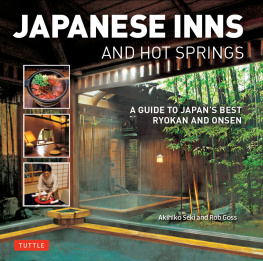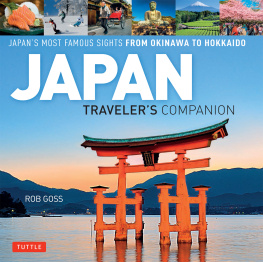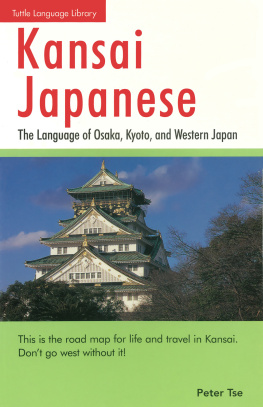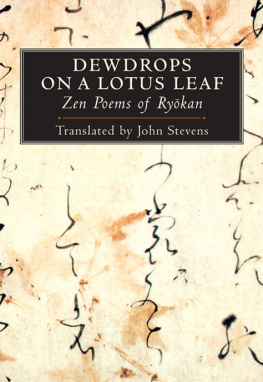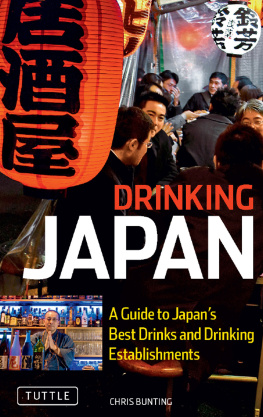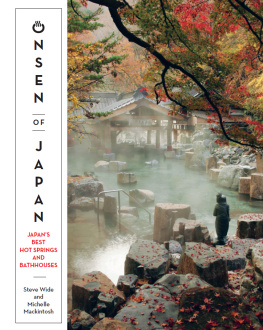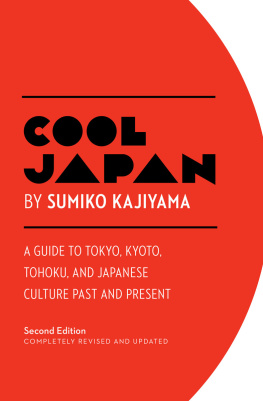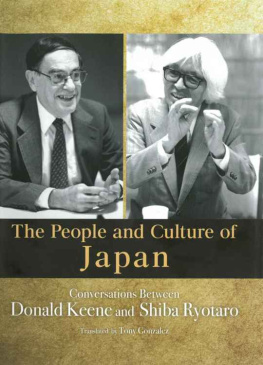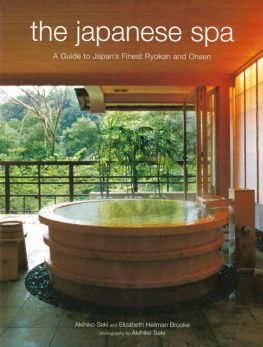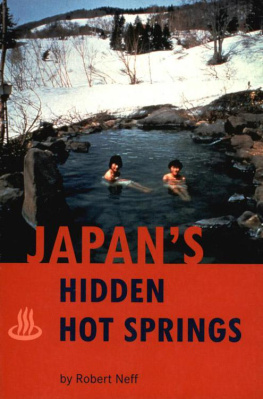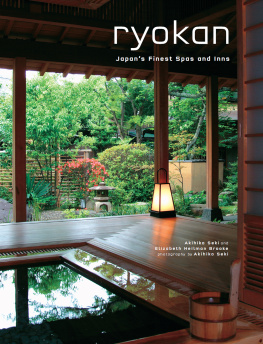A GUIDE TO RYOKAN ETIQUETTE
E ntire books have been written on Japanese business etiquette and social manners. In the most part, the intricacies dont apply to touristsjust use universal good manners and youll be finebut there are some particular rules for the ryokan that you should do your best to follow.
When to Remove Your Shoes
In the majority of ryokan, you take off your shoes in the entrance area before stepping into the ryokan, store them in the lockers or on the shoe shelves available, and then change into slippers to be worn around the communal areas of the ryokan. When you get to your room, you then remove your slippers at the rooms genkan (the small entrance area), going barefoot or in socks on the tatami mats. There can be variations, of coursesome ryokan, for example, allow shoes throughout the communal areas, but you then take these off at your genkan which can make things a little confusing. A simple guideline is to never step on tatami with shoes or slippers on and, wherever else, look out for slippers. If slippers are laid out, its a good bet you should be using them.

At Asaba (pages ), you are personally greeted by the okami who will look after you during your stay. Remember to remove your shoes at the entrance! (She will store them for you.)
Luggage
As well as removing your shoes at the entrance, at most ryokan this is also where staff will collect your luggage from you. If you end up carrying your own luggage to your room, lift it up if you can, so that the wheels dont bring in dirt from outside or damage the flooring. In your room, dont keep the luggage on the tatami or in the tokonoma . There will be closets or other areas to leave it.

Kinmata (pages ). Your luggage will be brought to your room. Be very careful not to damage the tatami mats, paper screens and furniture in the room or public areas. If anything is damaged, you might be asked to pay for the cost of repairing or replacing the items.

Hiiragaya (pages ). Paper shoji screens are exquisitely beautiful but also extremely fragile. Please be careful when opening them.
Bath Time
First up, change into the cotton yukata gown left for you in your room before going to the bathhouse (you can wear this throughout your stay), and take one of the room towels with you as not all ryokan have towels in the bathhouse. Once there, get naked, leaving your yukata and anything else in one of the wicker baskets or lockers in the changing room next to the actual bath room. Unless you are at a mixed-gender bath (although many of these are nude only, too) the only thing allowed in the bath is youno bathing shorts, towels, or anything else to protect your modesty.
Next, the most important thing is to wash before getting in the bath. As a foreigner, you can be forgiven for many faux pas in Japan, but polluting a communal bath with soap or dirt is one cardinal sin that nobody gets away with. Before getting in the bath for a long, hot soak, take a seat on one of the little stools by the low showers and wash and fully rinse (making sure to rinse off any soap and bubbles from the stool too) before heading for the bath. Enter the bath gently, as its rude to disturb the water too much, and then relax.
Tipping
Basically speaking: no. Whether at a taxi, restaurant, hotel or anywhere else, tipping is very rarely done in Japan. In almost all situations, simply trying to tip someone would cause embarrassment. That said, with very high-end ryokan there is an old custom (seldom followed nowadays) of offering a gratuity for staff who were particularly helpful. This is done by slipping a little cash (2,000 to 3,000) into an envelope and discreetly handing it over. Again, you arent expected to do this (quite the opposite), and you may be politely refused. If you want to leave something to say thank you for a great stay, give the staff a box of cookies or something similar when you check out. Really, though, a genuine thank you and smile is more than enough.

The first course of a meal at Kinmata (pages ). Breakfast and dinner at a ryokan are both lavish affairs requiring many hours of preparation by the kitchen. You will be asked to confirm your preferred meal times in advance. Be punctual to avoid disrupting the ryokan's carefully choreographed schedule.
Noise Levels
You dont have to whisper or walk around like you are on eggshells, but the peace and quiet is something that makes ryokan so special. In common areas especially, a little common sense will go a long way when it comes to noise and, if you are traveling with kids, make sure they arent running amok.
Meals
Ingredients are ordered to meet the days demand, so dont make any last-minute menu requests as the ryokan might not be able to accommodate them. If you have special dietary requirements, let the ryokan know before you arrive. Be aware that dinner timings tend not to be flexible, beyond perhaps the choice of dinner at 6:30 or 7pm, as the chefs will cook all the intricate dishes at one time on a tight schedule, to be served at once. When youve set the time, you need to stick to it. Ryokan wont hold a meal for you, as they wont want to serve food that isnt at its freshest.
A TRADITION OF FINE HOSPITALITY
A s anyone who has stayed at a ryokan will tell you, the experience is more than a window to classic Japan, it affords an opportunity to immerse yourself in tradition; to experience old Japan as the Japanese have done for generationsin a way that is unadulterated, unhurried, and undoubtedly unforgettable.
Like so much of Japans richly woven cultural tapestry, the ryokan has a long and winding history that has seen it develop from humble beginnings to todays pampering retreat. Delve into the ryokans roots and youll be reaching back to the Nara period (710784), a time when the political, social and religious structures of classical Japanese civilization were taking shape. It was then that simple but free rest houses for travelers called fuseya first appeared. They were run by Buddhist monks to help keep travelers from the perils of the road.
In the Heian era (7941191), a rise in the popularity of pilgrimages among the elite classes saw a twist on fuseya arise, with feudal manors and temples opening themselves to pilgrims. Its hard to know just how spartan the lattercalled shukubo would have been back then, but the modern-day version of temple accommodation is a fascinating experience for pilgrims and tourists alike. In Koya-san, the mountain-top town home to the Shingon sect of Buddhism, almost half of the one hundred or so temples and monasteries that hug the mountain provide almost ryokan-like shukubo , with modest tatami-mat rooms but exquisite vegetarian shojin-ryori cuisine and opportunities to experience temple life by attending morning prayers and meditation.
Its difficult to entirely separate shukubo from ryokanmany current ryokan, for example, were once shukubo. But as temple lodgings developed on major travel routes, along with the development of roads, bridges, and small towns, so did accommodation for non-pilgrims. Initially, this took the form of simple lodgings called kichin-yado , where guests received no meals but were able to seek shelter from the elements. Guests were charged not for their rooms here, but for the wood they would use to cook and keep warm with. By the time of the Edo era (16031868), a developing economy and increased internal trade saw more travel, and the appearance of accommodation called hatago , offering merchants and other travelers a more comprehensive version of kichin-yado , with meals provided and accommodation fees charged.

